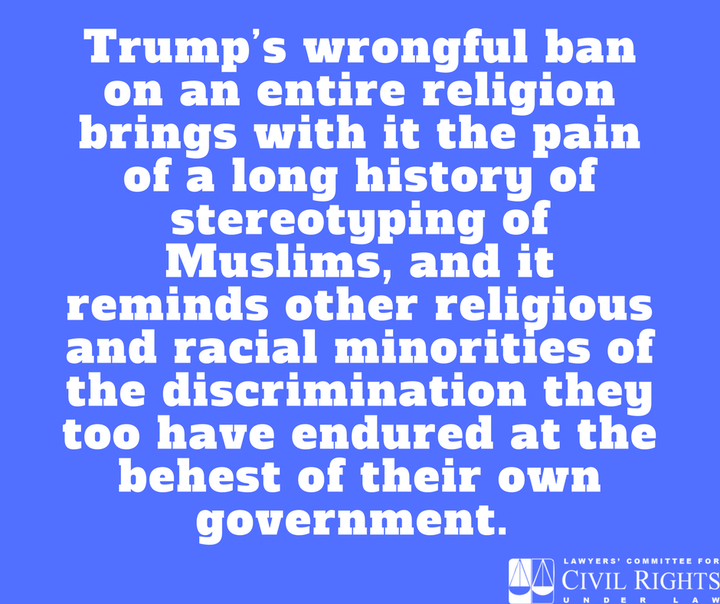
Despite temporarily letting President Trump’s discriminatory Muslim ban to go forward, the Supreme Court still has an opportunity to address whether we as a country will judge individuals as individuals or based on their religion, race, or ethnicity. History is on the side of progress and inclusiveness, and the justices should recognize what we already know—that a religious litmus test goes against the very foundation on which our country was built.
Trump’s wrongful ban on an entire religion brings with it the pain of a long history of stereotyping of Muslims, and it reminds other religious and racial minorities of the discrimination they too have endured at the behest of their own government. It is important to remember this history, and our continued efforts to confront and correct it, as the justices eventually hear oral arguments in the case.
As early as the colonial days, Cotton Mather – the Puritan minister who supported the Salem witch trials – called Muslims “monsters” and “devils.” Aaron Burr similarly stereotyped Muslims by denouncing “that false Prophet and great Imposter Mahomet [Mohammed].” These attitudes continued into the 20th Century.
Why does stereotyping matter? As the Supreme Court has recently and consistently recognized in addressing race and gender discrimination, stereotyping can be powerful evidence of discriminatory intent and motivation. Psychological research has confirmed that individuals have a strong tendency to defer blindly to “priming” – influences from individuals in position of power, such as the President of the United States.
President Trump’s stereotyping of Muslims as “bad people” and “terrorists” is of a piece with stereotyping of African Americans from slavery, up through segregation, and to today. But his brazen attempt to impose a religious litmus test through his travel ban goes even farther by denigrating entire communities of people based on a specific attribute. And on this point, the Supreme Court has acted before to say that such a targeted effort at discrimination violates the Constitution.
This progress took years, and we cannot roll back the clock now. Opponents of the Thirteenth Amendment argued African Americans were an “inferior race” suited to slavery. Similarly, when President Wilson reinstated segregation in the federal workforce, he told an African-American delegation that “segregation was not humiliating, but a benefit” for the newly segregated employees to be kept separate from their white co-workers and supervisors.
President Trump has stereotyped immigrants and religious minorities on seemingly moralistic grounds. He called Mexicans “rapists” and more, and he has implied that those opposing white supremacists and Nazis are “violent.” These stereotyped statements by political leaders serve to reaffirm the legitimacy of discrimination and violence against immigrants and minorities, putting the government’s imprimatur on institutionalized racism.
In recent times, stereotyping of Muslims has inspired violent attacks on individuals and mosques. A week after his inauguration, President Trump issued his very first Executive Order which banned all nationals from seven majority-Muslim countries. He told the public the Order was “about keeping bad people (with bad intentions) out of the country!” Instead, his actions brought a new wave of anti-Muslim violence, which arose in the shootings of Muslims (and even a Sikh who appeared to be Muslim) in Kansas and Washington, and attacks on mosques in Texas, Florida, and Minnesota. But the courts gave way for hope, rejecting various attempts at a Muslim ban.
The third Executive Order turns immigration law on its head. Decades ago, Congress replaced the country-by-country quotas that favored white northern Europeans with a broader approached based on individualized determinations of each immigration applicant. By placing a ban on immigration from certain countries, the Executive Order is less reliable and based on stereotypes, rather than a person’s background. The immigration ban also divides families, including children from their parents, and elderly people from their younger relatives – as the lower courts have recognized in striking down the ban on grandparents from joining their relatives in this country.
In the 1800s, the Supreme Court made decisions, reviled to this day, based on stereotypes of African Americans in Dred Scott v. Sandford affirming the right to own slaves and Plessy v. Ferguson upholding segregation. But finally years later came progress, in Brown v. Board of Education, Loving v. Virginia, and Obergefell v. Hodges. Now, the Supreme Court has an opportunity to be on the right side of history and put a stop to this new wave of stereotyping in deciding the Muslim Ban cases. It can reaffirm the right of every human being, no matter their religion, ethnicity, or color, to be judged as to his or her own merits, in accordance with the laws and Constitution of the United States.
Kristen Clarke is president and executive director of the Lawyers' Committee for Civil Rights Under Law. Alan Kabat is a partner at Bernabei & Kabat, PLLC.
